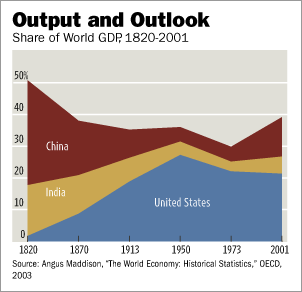I'd say it is!
In today's Wall Street Journal, Michael Milken points out:China and India combined to produce nearly half the world's economic output in 1820 compared to just 1.8% for the U.S. Our remarkable growth since 1820 has benefited from democratic institutions, a belief in capitalism, private property rights, an entrepreneurial culture, abundant resources, openness to foreign investment, the best universities, immigration and relatively transparent markets.That graph is truly striking.
At it's heyday in 1820, China had a greater share of the world's GDP than the US currently does and India wasn't far behind where we are now. My guess is that the change in ratios has much less to do with economic decline in either of those countries, than it has to do with stellar economic growth of the US over the past 200 years. A small difference in a percentage of growth rate over that span of time can amount to incredibly large differences in outcomes.
For example, if the US had grown at 1% less per year over the past 200 years, we'd currently be at 1/7th the level of GDP we currently have. That would put us below Mexico's current level of economic development -- more on par with a country like Guatemala or El Salvador.
It is very difficult to think of many issues more critical to a nation than economic growth. It dictates quality of health care, longevity, education levels, santiation, environmental conservation, povertry levels, nutrition, and much, much more.
Thinking about this really gives one pause. Stuff like this is what got me interested in economics. Particularly after seeing first-hand some truly impoverished regions in countries like Haiti, Brazil, Namibia, India, Panama, and Moldova. I couldn't stop thinking about why they were so poor and the US so rich?

No comments:
Post a Comment